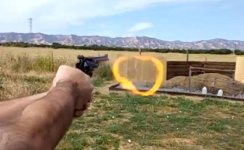...and we're back.
I'm happy to report my first range trip with my 357/44 B&D Model 27 was an unqualified success!
It was the first time I ever played with a chronograph. I was therefore not so concerned with pinpoint accuracy as I was with load functioning, and not blowing my new chronograph to smithereens.

I used the Hornady data (published in my other thread on 357/44 load data) with the expectation that I would not get to go all the way up to their max load, since their data was tested in and intended for the T/C Contender. I was using new Midway cases, WLP primers and WW-296 powder, with Hornady 158gr XTP bullets, and my Model 27 has a 6.5-inch barrel. The average velocity for five-shot strings was:
20.0 — 1469
20.5 — 1485
21.0 — 1472
21.5 — 1546
22.0 — 1552
22.5 — 1585
I started getting adverse pressure indications at 22.5, in the form of slightly flattened primers and difficult case extraction, so I stopped there although I had loaded rounds through 24.0 (24.9 was max published).
It is very fun to shoot, although one could make the case that similar results could be achieved more easily by simply ignoring published 357 Magnum data and overloading those cases, to bring them up to 1935-era pressures and performance. I suspect if you were to find a box of 357 Magnum factory ammo from the late 1930s it would deliver similar performance to the B&D, but these days the cartridge has been downloaded due to the preponderance of revolvers having smaller, lighter frames. The max load for 357 Magnum using 296 in the Hornady book is 1250 FPS.
Now that I know where the limits are, I will likely brew up a few batches of 21.5 and 22.0 and shoot for accuracy next time. I have a feeling it will be very effective.
Thanks to all who offered words of wisdom. I heard privately from several people who said they had B&D revolvers (or cylinders) gathering dust in the back of their gun safes. I hope this inspires you to get them out and enjoy them!
As an aside, I was also shooting 357 Auto Mag with the same bullets and almost the same loads, with both 6.5 and 8.5-inch barrels. Here are those results:
6.5-inch:
21.5 — 1632
22.0 — 1631
22.5 — 1686
8.5-inch:
22.0 — 1770
22.5 — 1788
The Auto Mag gets about 75-100 FPS more with the same load and barrel length, likely due to the lack of the barrel/chamber gap. Barrel length is slightly misleading because automatic barrels include the chamber as part of the barrel length. So the 6.5 inch auto barrel is really more like 5 inches of actual barrel.
Fun stuff!









